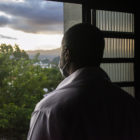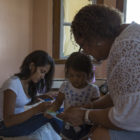I-Team In-Depth
Targeting Disparities In Colorectal Cancer Screening
|
Wilfredo Estrada, a 71-year-old New Haven resident and native of Peru, says getting colonoscopies is “muy necesario.” His father died from colon cancer at age 65, and he knows family history plays a role in cancer risk. Estrada described his odyssey fighting polyps detected by preventive colonoscopy screenings, which he has been getting since 2018. During the most recent procedure, Estrada says, the doctor found and extracted 29 polyps, all noncancerous. When asked if he tells people he knows how important it is to get screened, Estrada responded through his interpreter, “No. It’s not something I like to share with others.”
By staying current with colonoscopies, Estrada is doing his part to avoid becoming a cancer statistic.




